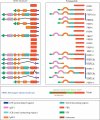The primary role of fibrinogen-related proteins in invertebrates is defense, not coagulation
- PMID: 21063081
- PMCID: PMC3031514
- DOI: 10.1159/000321882
The primary role of fibrinogen-related proteins in invertebrates is defense, not coagulation
Abstract
In vertebrates, the conversion of fibrinogen into fibrin is an essential process that underlies the establishment of the supporting protein framework required for coagulation. In invertebrates, fibrinogen-domain-containing proteins play a role in the defense response generated against pathogens; however, they do not function in coagulation, suggesting that this role has been recently acquired. Molecules containing fibrinogen motifs have been identified in numerous invertebrate organisms, and most of these molecules known to date have been linked to defense. Moreover, recent genome projects of invertebrate animals have revealed surprisingly high numbers of fibrinogen-like loci in their genomes, suggesting important and perhaps diverse functions of fibrinogen-like proteins in invertebrates. The ancestral role of molecules containing fibrinogen-related domains (FReDs) with immunity is the focus of this review, with emphasis on specific FReDs called fibrinogen-related proteins (FREPs) identified from the schistosome-transmitting mollusc Biomphalaria glabrata. Herein, we outline the range of invertebrate organisms FREPs can be found in, and detail the roles these molecules play in defense and protection against infection.
Copyright © 2010 S. Karger AG, Basel.
Figures

References
-
- King N, Westbrook MJ, Young SL, Kuo A, Abedin M, Chapman J, Fairclough S, Hellsten U, Isogai Y, Letunic I, Marr M, Pincus D, Putnam N, Rokas A, Wright KJ, Zuzow R, Dirks W, Good M, Goodstein D, Lemons D, Li W, Lyons JB, Morris A, Nichols S, Richter DJ, Salamov A, Sequencing JG, Bork P, Lim WA, Manning G, Miller WT, McGinnis W, Shapiro H, Tjian R, Grigoriev IV, Rokhsar D. The genome of the choanoflagellate Monosiga brevicollis and the origin of metazoans. Nature. 2008;451:783–788. - PMC - PubMed
-
- Matsushita M, Fujita T. The role of ficolins in innate immunity. Immunobiology. 2002;205:490–497. - PubMed
-
- Putnam NH, Butts T, Ferrier DE, Furlong RF, Hellsten U, Kawashima T, Robinson-Rechavi M, Shoguchi E, Terry A, Yu JK, Benito-Gutierrez EL, Dubchak I, Garcia-Fernandez J, Gibson-Brown JJ, Grigoriev IV, Horton AC, de Jong PJ, Jurka J, Kapitonov VV, Kohara Y, Kuroki Y, Lindquist E, Lucas S, Osoegawa K, Pennacchio LA, Salamov AA, Satou Y, Sauka-Spengler T, Schmutz J, Shin IT, Toyoda A, Bronner-Fraser M, Fujiyama A, Holland LZ, Holland PW, Satoh N, Rokhsar DS. The amphioxus genome and the evolution of the chordate karyotype. Nature. 2008;453:1064–1071. - PubMed
-
- Millar DA, Rateliffe NA. Invertebrate. In: Turner RJ, editor. Immunology, a Comparative Approach. New York: Wiley; 1994. pp. 29–60.
Publication types
MeSH terms
Substances
Grants and funding
LinkOut - more resources
Full Text Sources

